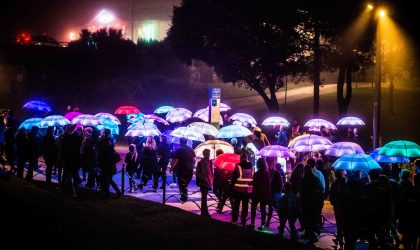
Beginner Read Audience Data Collection and Evaluation
Audience research is the process of gathering information about the people who visit you or see your work, use your services, or engage with your organisation.
In this article

Jamael Westman in Dr Seuss’s The Lorax; Photo credit: Manuel Harlan
Elizabeth Charlesworth is the Head of Communications and leads the Communications team which encompasses social, content, press and digital design at the Old Vic, an independent creative powerhouse for entertainment and education. A not-for-profit theatre, proud to be a charity. We believe that theatre makes the world better and that anyone should be able to access and experience it – to understand it, entertain it and benefit from it.
We are uniquely placed to achieve all of this as a large 1,000 seat theatre in the heart of London, focusing on creating equal access. We make world-class entertainment on an international scale, reaching audiences of over 350,000 every year through eclectic seasons of work, and a further 10,000 through free programs for engagement, employment, and social mobility. Our duality is important to us. It unites us. We are so much more than the work we do on stage. We are about creative excellence and social good.
OLD VIC: IN CAMERA was The Old Vic’s response to closing its doors for the first time in over half a century. We remained committed to fully accessible live theatre and pioneering an innovative approach to ensure that audiences could continue to reap the benefits that only the shared experience of live theatre can bring, despite not being able to leave our homes. What began as a two-camera live-streamed performance with LUNGS, developed into a full production staged for this new live-streamed format with A Christmas Carol. These were not one-off performances – at its height, the run of OLD VIC: IN CAMERA spanned more than 15 live performances over a 10-day run.
When we closed our doors in March 2020, our Artistic Director Matthew Warchus said theatre ‘brings us together in the most empathetic and comforting way, and its fascination with the trials, tribulations and wonders of Life is itself a beacon of hope, wisdom, solidarity and optimism. In other words, theatre is exactly what we need more than ever right now and our sadness at dimming the lights is immense… Here at The Old Vic, we promise to do everything possible to maintain some kind of meaningful connection with our audiences during this time’.
This underpinned our ambitions for OLD VIC: IN CAMERA – it was the shared experience of live theatre that was under threat, and it was precisely that that we were committed to sustaining despite audiences not being able to leave their homes. Rather than sharing pre-recorded performances and making them available on-demand, they would be performed live on The Old Vic stage with the empty auditorium as its backdrop over the course of a short run – our ‘audience’ would watch live as it happened from all over the world, and every single performance would be live captioned and audio described.
Practically, this involved weeks of intense research, planning, testing and problem-solving as there was no one-size-fits-all solution for this approach. Not only did we have to think about the capture of the performance itself and how this would be filmed and streamed, but we also had to think about how it would be ticketed and how people would access the stream; what platform we would use; how we would provide real-time tech support for the audience; how many viewers we could have watching the performance and still be able to provide a high level of customer service and support; how we would get viewers to join before the start of the show to ensure they were happy with their setup; how we would ensure everyone would be ready to watch in the right time zone; what we would do in the event of a technical error during one of the live performances; how we would ensure every single performance was captioned and audio described – and this was also at a time when the majority of the team at The Old Vic were furloughed, so it was an exceptionally small team tasked with making all of this happen.
We worked with StageText and Roz Chalmers in the early planning stages to ensure that live captioning and audio description would be available across all of our live-streamed performances. We worked closely with Zoom to adapt the platform to enable us to adapt the webinar function for multi-camera live streaming of each performance, and to provide unique links for all bookers, a live in-stream Q&A function to offer immediate customer support, to adapt their language interpretation capabilities for live audio description and to utilise their existing live captioning capabilities. The captioners and audio describers were completely integral – because these shows were live, they had to be present for every single performance; it was not something that we could create in advance and just leave to run independently.

Michael Sheen in Faith Healer; Photo credit: Manuel Harlan
One of the most valuable things that we learned was the need for customer service even in the digital sphere – to add real value to these experiences you need to virtually be there for your customers if you have a live offering, as minor technical errors can have a huge impact on someone’s enjoyment of the experience you are providing. You have to think about the experience as a whole as you would if they were in-person experiences, and that takes a lot of people power and pre-preparation to accommodate.
OLD VIC: IN CAMERA demonstrated that we can, and we should be creative about the way we interact with our audiences. Digital has the power to break down immense barriers, be that in relation to accessibility requirements or providing a gateway into theatre for someone who might ordinarily think it is not a place for them.
It also demonstrated the power of live theatre, even when we physically cannot be together to experience it – seeing audiences from across the world settling down with their home-made pre-theatre snacks, transforming their living rooms into an ad-hoc auditorium and knowing that they are doing that together at the same time as thousands of people across the world (and time zones) was a true testament to this art form and the authenticity of live performance.
On a human level, it also demonstrated the true passion that people have for our theatre, both in terms of our team and our audiences, and the collective will to ensure it survives this period of great adversity.
In total, 108,810 households watched an OLD VIC: IN CAMERA live performance from 94 countries, with the peak number of households watching one performance reaching 5,000 households.
We quickly saw that this model provided a new level of accessibility – we were overwhelmed by the response from those who were shielding, isolating, and those for whom leaving the home had ceased to become an option during the pandemic. It allowed us to bring our theatre into the homes of people who ordinarily would not be able to visit us; people in different parts of the UK, in different countries – we also opened up A Christmas Carol to care homes residents and workers and offered them free tickets.
We are still examining how the OLD VIC: IN CAMERA series may develop and how that will work in tandem with our need to encourage audiences to visit the theatre in person again.
The Digital Culture Network is here to support you or your organisation. Our Tech Champions can provide free 1-2-1 support to all creative and cultural individuals and organisations who are in receipt of, or eligible for, Arts Council England funding. If you need help or would like to chat with us about any of the advice we have covered above, please get in touch. Sign up to our newsletter below and follow us on Twitter @ace_dcn and LinkedIn for the latest updates.
Beginner Read Audience Data Collection and Evaluation
Audience research is the process of gathering information about the people who visit you or see your work, use your services, or engage with your organisation.
Beginner Read Digital Accessibility
The goal of digital accessibility is to create digital products and services that are inclusive and provide equal access to information and functionality to all users, regardless of their abilities. This article aims to introduce you to the principles of digital accessibility, and shed some light on some of the things you need to know when creating accessible digital content.
Beginner Read Digital Strategy
An effective digital strategy can be vital to your organisation’s success. Read on to understand the key considerations when developing yours.
Beginner Read Email Marketing
Email marketing is a powerful tool when it comes to building relationships with your audience. Read on to find out more about what it can do for your organisation.
Beginner Read Box Office and Ticketing Customer Relationship Management CRM
Understanding your audience data can be your ticket to success. Read on to find out how to make the most of what your customers tell you.
Beginner Read Social Media
Social media is a unique and powerful way to help your organisation thrive and engage with your audience. Read on to find out more.




